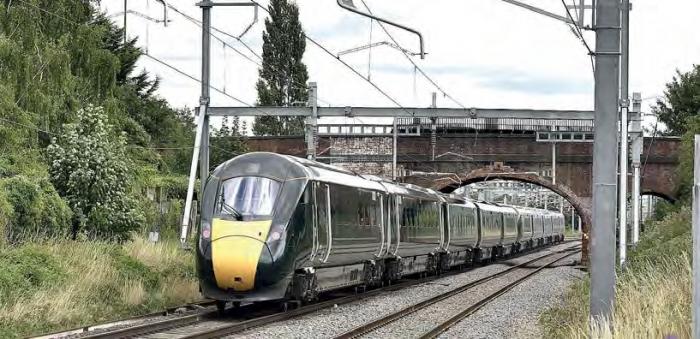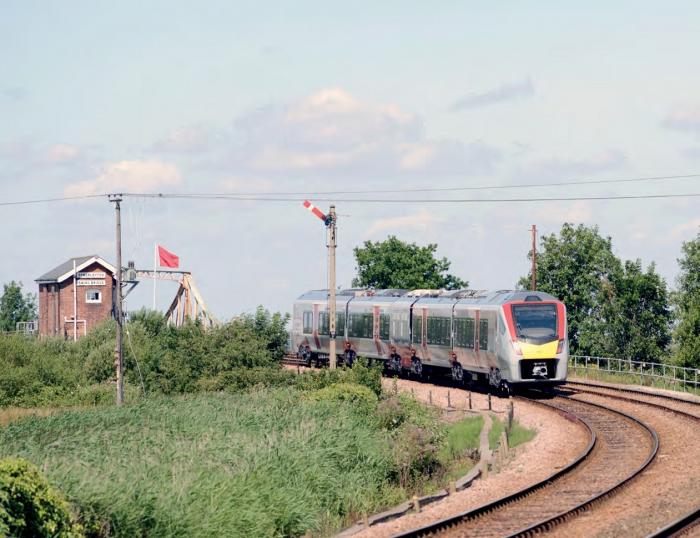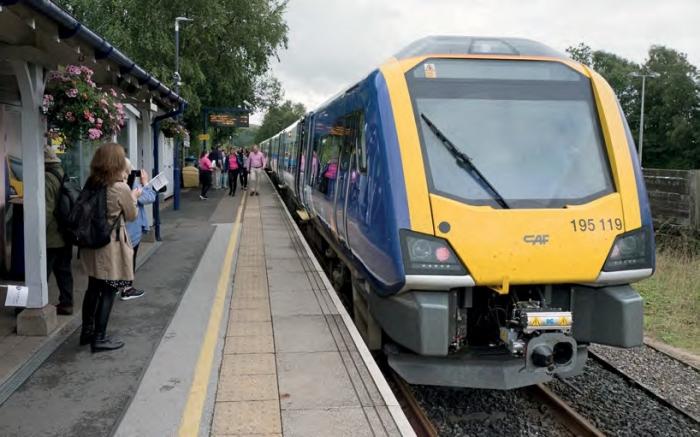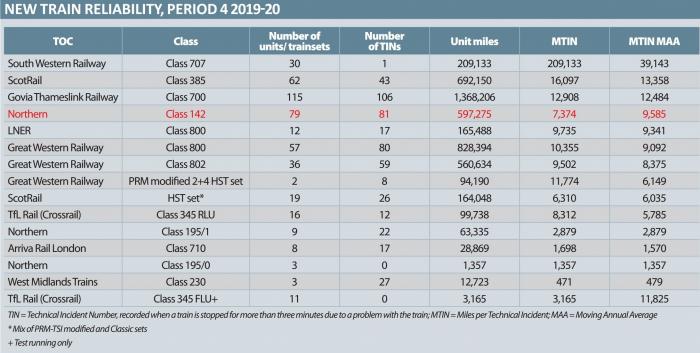Informed Sources
There are a few vacancies in the New Train TIN-watch table


More new entrants to the table this month, with Northern’s CAF Class 195 diesel multiple-units joining the fray. As a reminder of the Table of Truth’s long-standing benchmark, I have put Northern’s Class 142 Pacer fleet in red in its appropriate place in the ranking. (Can I quote Ozymandias? No – Ed.) Above the red line, Siemens’ Class 707s, with added Wimbledon fairy dust, continue to romp away. Below that Hitachi (Class 385) and Siemens (Class 700) remain roughly 1,000 MTIN apart.
While one should not pay too much attention to reliability during individual Reporting Periods, the Class 385s have been consistently around the 15,000 MTIN mark and are progressively knocking out less reliable periods as the moving annual average (MAA) moves on. (Can I quote Omar Khayyam? No again – Ed.) Meanwhile, the Class 700s have similarly plateaued at around 13,000 MTIN. However, rectification of issues with the closed circuit TV equipment is expected to see reliability growth restart.
In the battle of the bi-modes, the LNER and GWR fleets are neck and neck. I did wonder whether LNER had an advantage from less intensive diagrams, but the differences in mileage are insignificant.
STEVENTON
Good news for GWR is that the 60mph speed restriction at Steventon Bridge, which Class 800s avoided by running through the section under diesel power, has been lifted to 110mph since 14 September. This followed some good old-fashioned empiricism rather than modelling.
Analysis of real-time data from test runs at 125mph showed that operation at linespeed would, indeed, not be sustainable in terms of both contact wire life and pantograph wear. However, 110mph turned out to be acceptable, at a cost of only seven seconds’ delay. This also means that it is now down to the local authority to replace the aged structure.


SOFTWARE
One lesson from the table is that with this new generation of software-enabled trains, rolling stock engineers are entering new territory when it comes to reliability. Latest example of software on wheels syndrome are the much-anticipated Stadler Flirts on Greater Anglia.
When the trains were ordered in August 2016, service entry was quoted as ‘spring’ 2019, with both fleets in service by the end of 2019.
As I write it is officially autumn and five Class 755 bi-modes were available for service on the launch day (4 September), with one Class 745 electric multiple-unit reportedly on fault-free running.
Stadler’s bi-mode failures are largely engine-related, with sets sometimes failing on depot before even starting a diagram.
Stadler attributes the engine problems to software rather than physical issues such as overheating. The ‘755s’ should make their debut in next month’s table, when all will be revealed.
But Stadler’s problems are a minor inconvenience compared with those still facing Bombardier.
True, reliability of the Class 345 EMUs is respectable for new trains and the Class 710 Aventras have now been cleared for both AC and DC operations and have started running on the Watford DC lines.
However, the Class 701 order for South Western Railway (SWR) has now been confirmed as a year late.
Bombardier says first deliveries ‘in the spring’, while SWR MD Andy Mellors told The Evening Standard at the start of September that he expected to see the first trains in service ‘by the middle of next year’.
That is a model of exactitude compared with Greater Anglia Managing Director Jamie Burles who, commenting on the first Class 755s entering service in a stakeholder update at the end of August, said that the next stages involve ‘many more of the Stadler trains entering service this autumn (including the inter-city trains) and finalising the roll out plans for the Bombardier trains’.
Currently the show-stopper for the Greater Anglia Class 720s is multiple operation. According to Bombardier, clearance for ‘710s’ to run in multiple on Transport for London’s West Anglia Metro routes is expected later this year.
This software upgrade should then read across to the Class 720 fleet.
Meanwhile, DfT is singing ‘la la la’ with its fingers in its ears when the subject of the fast-approaching Persons with Reduced Mobility – Technical Specification for Interoperability deadline is mentioned. I foresee accessibility Armageddon when all the ex-British Rail trains, which have been maintained (safely) on the assumption that it would all be over by Christmas, are required to run on into another decade.
Examinations can be deferred for only so long. Spares stocks for obsolete parts become depleted, carriages have to be locked out of use. Winter is coming. That said, continuing heroic efforts at Crown Point depot are ensuring that No 90006 and friends are not going gentle into that good scrap yard.
The Greater Anglia loco-hauled inter-city trains are the eighth most reliable fleet on the network.

